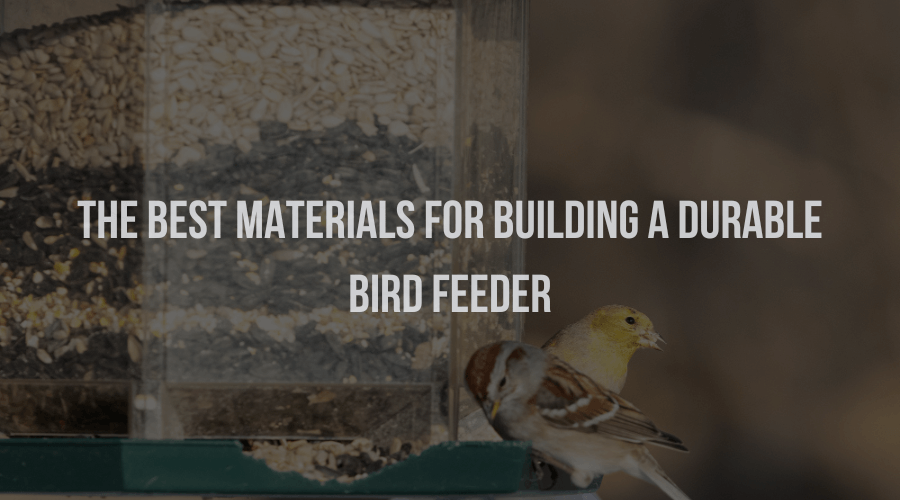Bird watching is a popular hobby for many nature enthusiasts. The sight of a beautiful bird perched on a bird feeder, filled with nutritious recipes for birds, is a joy to behold. But, building a bird feeder that lasts can be a challenge. Bird feeders are often subjected to harsh weather conditions, bird droppings, and other environmental factors. Therefore, selecting the right materials is essential for building a durable bird feeder.
In this blog, we will discuss the best materials for building durable bird feeders. We will also explore different types of bird feeders and the materials used in making them.
Types of Bird Feeders
Before we delve into the materials used in making bird feeders, let’s take a look at the different types of bird feeders available in the market.
1. Hopper Feeders
Hopper feeders are one of the most popular types of bird feeders. They are designed to hold a large amount of birdseed, and they dispense it slowly. These feeders are usually made of wood or plastic.
2. Tube Feeders
Tube feeders are cylindrical in shape, and they are usually made of plastic or metal. They have small ports from which birds can access the birdseed. The advantage of tube feeders is that they are easy to clean and maintain.
3. Suet Feeders
Suet feeders are designed to hold suet cakes or other fat-based bird foods. They are usually made of wire mesh or plastic-coated wire. The advantage of suet feeders is that they attract a wide variety of birds.
4. Platform Feeders
Platform feeders are flat surfaces that hold birdseed. They are usually made of wood or plastic. The advantage of platform feeders is that they are versatile and can accommodate a variety of bird species.
Materials Used in Making Bird Feeders
1. Wood
Wood is a popular material used in making bird feeders. Cedar and redwood are two types of wood that are naturally resistant to insects and rot. The advantage of using wood is that it blends well with the environment and looks attractive. However, wood requires regular maintenance, and it may not last as long as other materials.
2. Plastic
Plastic is a lightweight and durable material that is commonly used in making bird feeders. It is resistant to weather and requires little maintenance. However, plastic may not be as aesthetically pleasing and healthier as other materials.
3. Metal
Metal bird feeders are strong and durable. They can withstand harsh weather conditions and are resistant to damage from squirrels and other animals. However, metal bird feeders can be expensive and may require regular maintenance to prevent rust.
4. Glass
Glass bird feeders are beautiful and can add a touch of elegance to your garden. They are easy to clean and maintain. However, glass is fragile and may break easily.
5. Leather
Leather bird feeders are a relatively new addition to the market. They are made from high-quality leather and are designed to last for years. The advantage of leather bird feeders is that they are not only durable but also stylish. Leather bird feeders blend in well with the environment and add a touch of sophistication to your garden. Additionally, leather bird feeders do not require any maintenance.
Leather Bird Houses - A Better Alternative
Leather bird houses are becoming increasingly popular among bird enthusiasts. They are made from high-quality leather and are designed to last for years. The advantage of leather bird houses is that they are not only durable but also stylish. Leather bird houses blend in well with the environment and add a touch of sophistication to your garden.
Leather bird houses have several advantages over traditional bird houses made from wood or other materials.
- Firstly, leather bird houses are lightweight, making them easy to install and move around.
- Secondly, leather bird houses are not affected by harsh weather conditions, such as rain or snow, as leather is naturally water-resistant. Additionally, leather bird houses do not require any maintenance, making them a hassle-free option for bird enthusiasts.
- Furthermore, leather bird houses are also environmentally friendly. Unlike wooden bird houses, which require cutting down trees, leather bird houses are made from a renewable resource. Leather is a by-product of the meat industry and can be sustainably sourced.
- In terms of durability, leather bird houses are designed to last for many years. They are made from high-quality leather that is resistant to wear and tear. Additionally, leather bird houses can withstand harsh weather conditions and are not affected by pests, such as termites or carpenter ants.
Conclusion
Selecting the right materials for building a durable bird feeder is crucial for any bird enthusiast. While there are several materials available in the market, each with its own advantages and disadvantages, leather is emerging as a better alternative for bird houses. Leather bird houses, like those offered by Sparrow Daughter, are not only durable and long-lasting but also stylish and environmentally friendly, also empowering women through craftsmanship. They are lightweight, easy to install and move around, and require no maintenance, making them a hassle-free option for bird enthusiasts.
Additionally, leather bird houses blend in well with the environment and add a touch of sophistication to any garden. Therefore, we highly recommend Sparrow Daughter‘s handcrafted bird houses, bird baths, bird feeders, and much more to all bird enthusiasts looking for a durable, sustainable, and aesthetically pleasing solution for their feathered friends.

